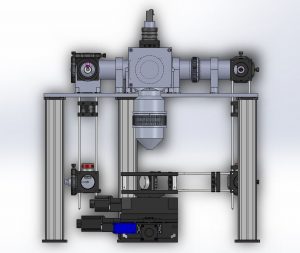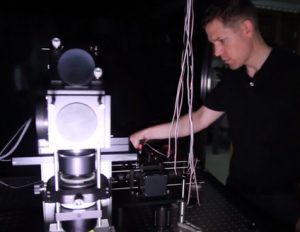The five-year NSF project led by UNC researcher Spencer Smith will develop new imaging systems and technology to explore the brain like never before.

The five-year NSF project led by UNC researcher Spencer Smith will develop new imaging systems and technology to explore the brain like never before.

Media contact: Mark Derewicz, 984-974-1915, mark.derewicz@unchealth.unc.edu
August 1, 2017
CHAPEL HILL, NC – The brain is so incredibly important to human health and yet so little is known about how it works. MRIs and other kinds of scans can reveal important things about brain health in broad strokes to aid in diagnostics, but they aren’t able to uncover important details of brain function, such as how neurons talk to each other. This is where Spencer Smith, PhD, and his lab at the UNC School of Medicine come in.
Smith, an associate professor of cell biology and physiology and member of the UNC Neuroscience Center, is a world expert in developing multiphoton imaging systems – an evolution of the standard microscope – and using them to observe brain activity in much greater resolution than MRIs, down to individual brain cells.
To help further Smith’s work, the National Science Foundation (NSF) awarded him $10 million over five years. He will lead a consortium, including his lab and eight other scientific teams across the country. This is part of the NSF’s new NeuroNex Awards, which bring together researchers from across various disciplines to create new technologies and explore the mysteries of the brain like never before. By the end of five years, the NSF hopes to have established a national infrastructure to enhance our understanding of brain function.
“This is an ambitious project I’m excited to be part of,” Smith said. “Our goal is to create the next generation of multi-photon neuroimaging technology to provide unprecedented views into brain activity with the goal of learning as much as possible about how the brain works in health and disease.”
Smith’s project can be summarized in three parts:
• Develop imaging systems to make currently impossible neuroscience experiments possible.
• Disseminate multi-photon neuroimaging technology through open source and commercial enterprises to allow a broad community of neuroscientists to take advantage of the new technology for new research projects.
• Advance the basic physics and engineering technology to lay the groundwork for future neuroimaging technologies.

Multi-photon imaging – usually two-photon or three-photon – uses a quantum mechanical effect to see deep into the brain relatively non-invasively. The imaging systems use bursts of light so intense that the cellular molecules absorbing the light can’t tell where one photon ends in the beam of light and the next photon begins. This is crucial because brain tissue is like a bramble of intertwined cells that conventional microscopes can’t penetrate. Looking through a conventional one-photon microscope, only blurry images can be seen.
Multi-photon imaging systems use lower energy photons that scatter less in the brain so that researchers can see a particular image deeper. Multi-photon absorption occurs only at high intensities right at the focal point to limit background clutter. The result is a much clearer image into deep tissue to reveal the structure of tiny things.
Smith though, is taking this process a step further. His goal is to view these tiny structures in a field of view so wide that he can see over a million neurons, across multiple brain areas, at incredibly high resolution.
But to see such tiny structures in a large field of view, Smith’s team had to custom design the imaging systems, build the systems themselves, and then have the experimental know-how to test them. He has built prototypes at UNC and used them experimentally since joining the UNC School of Medicine in 2013.
“We want to create the next generation of multiphoton imaging to enable neuroscientists to explore the brain in new ways, making previously impossible experiments possible,” Smith said. “This technology is critical for basic, fundamental brain science, as well as understanding disease processes and potential therapies.”
Check the Next Generation Multiphoton Neuroimaging Consortium website for more information.